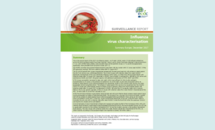Influenza virus characterisation, Summary Europe, December 2017
This is the second report of the 2017–18 influenza season. As of week 1/2018, nearly 37 000 influenza detections across the WHO European Region have been reported. Types A and B viruses have been detected in equal proportions (~1:1), with A(H3N2) being slightly more prevalent than A(H1N1)pdm09 viruses (1.7:1) and B/Yamagata being significantly more prevalent than B/Victoria viruses (28.7:1).
Executive Summary
Ten EU/EEA countries have shared influenza-positive specimens with the London WHO CC since week 40/2017. Of the 280 specimens received, 268 have collection dates after 31 August 2017.
The 20 A(H1N1)pdm09 test viruses characterised antigenically showed good reactivity with antiserum raised against the 2017–18 vaccine virus, A/Michigan/45/2015. The 12 test viruses with collection dates from week 40/2017 genetically characterised at the Crick Worldwide Influenza Centre (WIC), as others from the European Region with collection dates after 31 August 2017 deposited in GISAID, have all fallen in subclade 6B.1, defined by HA1 amino acid substitutions S162N and I216T, the great majority with additional substitutions of S74R, S164T and I295V.
Of 50 viruses successfully recovered to date, only eight (16%) had sufficient HA titre to allow antigenic characterisation by HI assay in the presence of oseltamivir. Six of the eight viruses were recognised well by an antiserum raised against a cell culture-propagated virus genetically similar to the currently used vaccine virus (eggpropagated A/Hong Kong/4801/2014). The antiserum raised against this vaccine virus recognised only the minority (25%) of viruses well. While genetic analysis of these viruses is pending, others from the European Region with collection dates after 31 August 2017 as deposited in GISAID, fall within the 3C.2a genetic clade, with a minority falling in the 3C.2a1 genetic subclade. Of the 14 viruses with collection dates from week 40/2017 characterised at the WIC, 10 were clade 3C.2a and four subclade 3C.2a1.
Of the five B/Victoria-lineage viruses tested, three reacted well with post-infection ferret antisera raised against tissue culture-propagated surrogates of B/Brisbane/60/2008. The remaining two, one each from France and Spain, reacted well with an antiserum raised against tissue culture-propagated B/Norway/2409/2017 that carries an HA1 double amino acid deletion (Δ162-163). Of the four viruses characterised genetically at the WIC, three fell within clade 1A (including the only one with a collection date after week 40/2017) while the fourth fell within the subgroup (1A(Δ2)) carrying the HA1 double amino acid deletion.
All 16 B/Yamagata viruses characterised antigenically reacted well (within fourfold of the homologous titre) with postinfection ferret antiserum raised against egg-propagated B/Phuket/3073/2013, the recommended vaccine virus for use in quadrivalent vaccines for the northern hemisphere 2017–18 and for trivalent vaccines in the southern hemisphere 2018 seasons. The nine viruses with collection dates from week 40/2017 genetically characterised at the WIC, as others recently circulating in the European Region and reported to GISAID, fall within clade 3.
Download

Related updates on influenza
More about influenza surveillance
Disease page
Seasonal influenza
Seasonal influenza is a preventable infectious disease with mostly respiratory symptoms. It is caused by influenza virus and is easily transmitted, predominantly via the droplet and contact routes and by indirect spread from respiratory secretions on hands etc.




